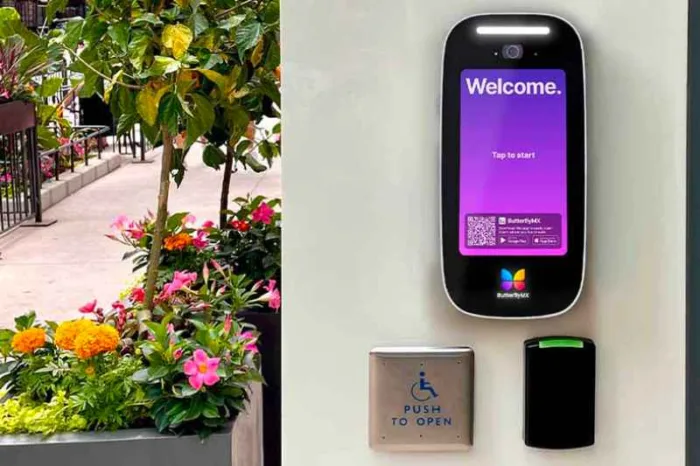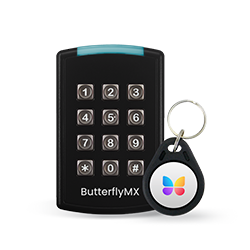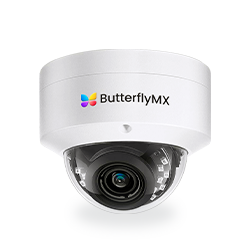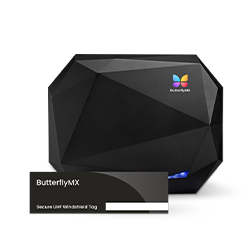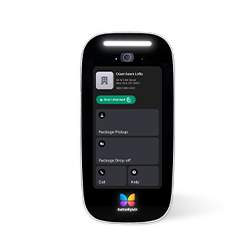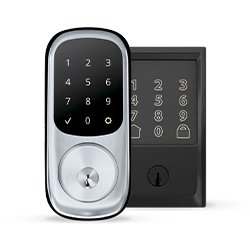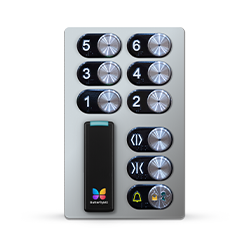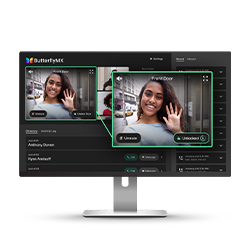Takeaways
- Door entry systems with cameras typically cost between $3,000 and $7,000.
- Contact the door entry system’s manufacturer to find a certified installer.
- Video door entry systems work by utilizing a base station at the door, a substation in the unit, and a door release.
- A video door entry system enhances security, convenience, and operational efficiency in residential and commercial properties.
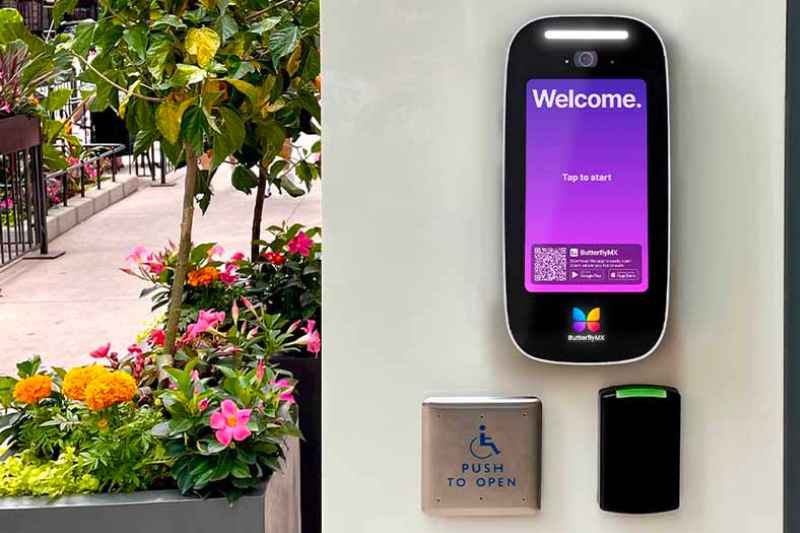
Also known as door access control systems, door entry systems are ideal security solutions for a wide range of properties. For an extra layer of security, consider a video door entry system that lets tenants see their guests before letting them inside.
With that said, finding the right video entry system is difficult when there are so many options. So, this guide will detail the best video door entry systems. In addition, you’ll discover the cost of door entry systems, how to find the right installer, and the types of systems available.
This post will cover:
More than 40K, 5-star reviews!
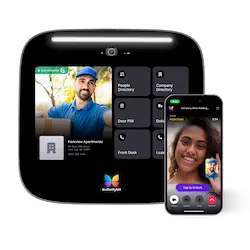
Video Intercoms
Open doors, gates & garages from anywhere.
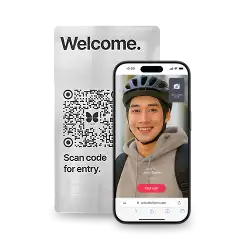
QR Code Intercom
Smartphone-based visitor access.
Access Control
Fob, key cards, PINs, and mobile apps.
Security Cameras
Visibility throughout your property.
Vehicle Access
Hands-free access for gates & garages.
Package Room
Receive, store, and manage deliveries.
Smart Locks
Connect to all major brands and models.
Elevator Controls
Unlock key-fobbed elevators for anyone.
Front Desk Station
See all your doors and cameras in one place.
What is a video door entry system?
A video door entry system, also known as a video intercom system, is a security and communication solution that allows residents or building occupants to see and communicate with visitors before granting access. Moreover, video door entry is commonly used in multifamily residential buildings, commercial properties, and gated communities to enhance security and convenience.
Key components of a video door entry system include:
- Door station. Usually installed at the building entrance or gate and it includes a camera, microphone, speaker, and sometimes a keypad or RFID reader for credential-based access.
- Monitor station. Features a display screen and audio system for residents or staff to see and talk to visitors. Plus, some systems have mobile app integrations that allow users to communicate remotely.
- Access control. Can include key fobs, PIN codes, biometrics, or remote unlocking via a mobile app. Furthermore, you can integrate with broader access control systems for seamless entry management.
- Network connectivity. Can be wired for reliability or wireless for flexibility. Modern systems often use cloud-based platforms for remote access and management.
How does a video door entry system work?
A video entry system works by using three primary components:
- Base station. Located at the main entryway, the base station is the intercom or interface that tenants or guests use to enter the building. It’s also the device that includes the directory and camera that tenants use to request entry into the property.
- Substation. Either as in-unit hardware or a smartphone, the substation is what receives the notification a guest has arrived. From the substation, a tenant can see and speak with the guest before granting access.
- Door release. Also known as the door lock, the door release is what keeps the door or gate secure. It will only unlock when an authorized credential is used.
So, when a visitor approaches a building, they can look up the tenant in the system’s directory and press the call button. Then, the base station calls the tenant. Next, the tenant gets a notification of the visitor’s call on either their smartphone or in-unit device and can talk to the visitor. Finally, once the tenant confirms the visitor’s identity, they press the door release button, which triggers the door release.
Watch how ButterflyMX works:
What are the benefits of installing a video door entry system?
A video door entry system enhances security, convenience, and operational efficiency in residential and commercial properties.
Here are the key benefits of installing one:
- Visual & audio verification. Empowers you and your residents to to see and speak with visitors before granting entry, reducing unauthorized access.
- Access logs. Many systems offer video recording and visitor logs, which can be useful for security audits and investigations.
Smartphone integration. With some video entry systems, you can connect to mobile apps, allowing you to answer the door and grant access from anywhere. - Multiple entry point management. Ideal for multifamily buildings and commercial properties, allowing access control for multiple doors and gates.
- Enhances resident experience. Provides an added sense of security and convenience, which can be a selling point for rental and condo properties.
- Reduces staffing costs. Buildings can rely on video verification instead of full-time security personnel.
- Expandable features. With a cloud-based video entry system, you can integrate with additional security cameras, keyless entry systems, and alarm systems.
- Custom access permissions. You can grant or restrict access to different users based on their roles, such as residents, staff, or visitors.
Types of video door entry systems
Video door entry systems for commercial, residential, and gated community properties implement a wide range of features, allowing for a variety of options to choose from.
The most common types of door entry systems with video functionality include:
IP video intercom
An IP (Internet Protocol) intercom system with a camera is a device that operates by using the internet. These types of systems work either wired or wireless, depending on their design. Wireless systems connect via WiFi, whereas wired systems connect directly to an access point via ethernet or Power over Ethernet (PoE) cable.
Regardless of how the intercom is connected, it sends and receives video signals to and from user’s phones, allowing for two-way communication. Above all, these signals are protected using end-to-end encryption, which is essential when maintaining data security for your property and tenants.
Wired door entry system
Traditional wired entry systems with video functionality require legacy or on-site servers to operate. In other words, wired door entry systems take up a lot of space and cost a lot because of the installation and maintenance process.
Wired entry systems must wire directly to tenants’ units where in-unit hardware is installed. Not only does this hardware add to costs, but it’s extremely complicated to install with so much wiring involved.
What’s more, wired systems require extensive maintenance by a professional technician. The system cannot be remotely updated unless retrofitted with the right equipment, but even then, it still takes up a lot of space.
Cloud-based video intercom
Also known as wireless door entry systems, cloud-based video intercoms are the best type of video door entry system. These devices store data in an off-site server known as the cloud. To do this, they connect to the internet, which is also how it sends and receives signals.
Unlike a wired system, wireless video intercoms replace in-unit hardware with tenants’ phones. So, when a guest selects the tenant’s name in the directory, their phone notifies them. Then, the tenant can see and speak with the visitor before granting them access remotely.
Additionally, with a cloud-based video intercom, your property can manage credentials, access permissions, and more remotely through an online dashboard or a mobile app. Moreover, the intercom receives new updates and even features over time, as the manufacturer can remotely deploy them at any time.
Cellular door entry system
Finally, cellular door entry systems use cellular signals to send and receive data. Unlike IP intercom systems, cell phone door entry systems with cameras require a cell phone network to operate. Thus, your intercom will require a cellular network to work. Nonetheless, tenants can grant access remotely and speak with visitors before letting them inside.
Choosing a robust video door entry systems
If you’re looking for a video door entry intercom system that can handle all your property’s needs, then check out the ButterflyMX Video Intercom.
ButterflyMX is a cloud-based access control company established in 2014. Since introducing the world’s first smart Video Intercom, we’ve expanded our offerings to encompass property-wide access, from the front door and garage to the elevators and individual units.
The ButterflyMX video intercom is the best door entry system because of the following features:
- Cloud-based. Using cloud-based infrastructure, the video intercom doesn’t require extensive wiring, simplifying installation and reducing associated costs. Not to mention, users can access the property and let their guests in remotely using the convenience of their smartphones.
- 156° wide-angle camera. See who is requesting access at the front door or gate through the intercom’s wide-angle camera. Thus, you can capture the entirety of your main entryway, offering peace of mind.
- Audit log. Review every guest or user entry with a clearly labeled audit log featuring time- and date-stamped photos. In turn, you can catch potential perpetrators in the event of a security breach.
- Remote access. Enable your property staff and tenants to control access to the property remotely using the online dashboard or the highly-rated ButterflyMX mobile app. This way, you can ensure tenants have a positive experience with your property while staff can manage access from anywhere.
- Built-in RFID. Offer the convenience of accepting multiple credentials with built-in RFID. Users can then access the property with a key card or fob, which further simplifies access.
- Delivery PINs. Assign delivery drivers a PIN code for easy access to the property. That way, residents won’t experience missed or delayed package deliveries.
- ButterflyMX platform. Use the video intercom alongside any of ButterflyMX’s other products for a unified access control system, simplifying holistic property access into one platform.
How to find an installer for your video intercom
For the best installation experience, contact the manufacturer of the video door entry system you want. They’ll connect you with a certified installer in your area, ensuring you receive all the benefits.
Certified installers are experienced and trained professionals who have the knowledge to install your video door entry system correctly. As a result, you’ll benefit from a properly installed system, a valid warranty, and a faster installation.
Video door entry system FAQs
- How much do video door entry systems cost?
- How much does it cost to install a door entry system?
- Are there wireless video door entry systems?
How much do video door entry systems cost?
On average, the cost of a video entry system is between $3,000 and $7,000.
However, the cost of an entry system will vary depending on many factors, such as:
- Type of system
- Features
- Manufacturer
Furthermore, the cost of the device does not include additional costs, such as installation and service fees. We recommend you get a quote to ensure you know all of your expenses before making a purchase
How much does it cost to install a door entry system?
Installing a video intercom or other door entry system costs between $1,000 and $3,000. Of course, costs may vary depending on the type of system, complexity of the installation, and the installer.
For the best experience, you should select a cloud-based entry system. These systems are simpler to install because they don’t require extensive wiring. Not to mention, the best video intercom systems offer multiple ways of connecting to the internet for buildings where a physical internet access point is hard to acquire.
Are there wireless video door entry systems?
Yes, wireless video door entry systems are available and are becoming increasingly popular due to their ease of installation, flexibility, and smart technology integration. Unlike traditional wired systems, wireless video door entry systems use WiFi, cellular networks, or radio frequencies to transmit video and audio signals between the door station and the mobile device.

Get your free quote!
Fill in the form below, and we'll email you right back.
Want a free quote?
Fill in the form below, and we'll email you right back.
You’ll be redirected shortly...
